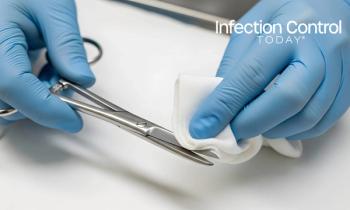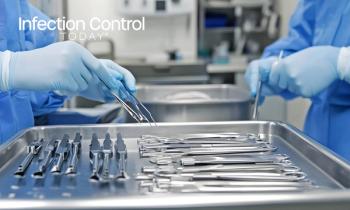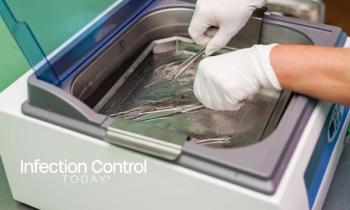
Cleanliness and Sterility Assurance in Central Sterile and the Operating Room
By William DeLuca, CRCST, CIS, CHL
In the operating room, having a sterile barrier system, commonly referred to as an SBS, provides a microbial barrier that allows devices to be sterilized and maintain sterility up to the point of use.
There are a variety of sterile barrier systems designed for different applications. These include bags, pouches and reels, preformed and semi-rigid trays, and sterilization wraps. For example, large sealed bags made from transparent films will have one area made from a permeable microbial barrier material to allow sterilization gases to enter. Header bags are used for large items like gowns and drapes as well as for kits (or sets of devices) for typical operating procedures.
If several items are packed in a header bag, they are normally in a tray or wrapped in a drape, to be removed later in one step. Pouches and reels are made from plastic film and a permeable microbial barrier material. This permeable microbial barrier is typically a medical grade paper, which allows access to the sterilizing agent. Pouches are commonly used as packaging for single instruments, small sets of instruments, and single-use medical products. Pouches are also available preformed or in a reel, which allow for larger volumes.
Preformed and semi-rigid trays come in a variety of sizes and materials depending on the type of product being packed. The formed tray typically comprises a permeable barrier material to allow access by sterilizing gases. These trays have filters to allow steriliants to access anything inside, and allow proper drainage and release. Paper bags are used by some hospitals for similar applications to pouches. They can be used either on their own for procedure packs or as part of the contents of a wrap tray or basket for holding instruments used during an operating procedure. Bags can either be heat sealed, or sometimes the top of the bag has a peel and stick seal. Sterilization wrap comes in a number of different weights, grades, colors and sizes. Wraps can be made of various materials, ranging from 100 percent crepe paper to nonwoven products such as synthetic reinforced papers. And, 100 percent polypropylene material wrap is often folded around trays and instruments to create a tortuous path, which creates a barrier to microbes and enables aseptic opening. It is important to note the details of the wrap material, because, according to the AAMI (1993):
The shelf-life of a packaged sterile item is event-related and depends on the quality of the wrapper material, the storage conditions, the conditions during transport, and the amount of handling. There should be written policies and procedures for how shelf-life is determined and for how it is indicated on the product.
Most wraps are secured by the use of sterilization autoclave tape. All medical devices are sterilized in their sterile barrier system before they're used. There are a variety of sterilization methods used. These include steam and Sterrad. The sterilant of the chosen sterilization method must be compatible with both the device and the barrier system. A medical device once sterilized must remain sterile until it's used. Barrier systems are able to keep medical products sterile for years, provided they do not get damaged. This is called event related sterility. Meaning that a package is sterile until it is damaged or soiled. The sterile device and its barrier system must be transported and stored according to recommended conditions. Aseptic presentation describes the opening and handling of sterile products to prevent microbial contamination and maintain sterility. The ability to present a product in an aseptic manner is a key feature considered in the design of the sterile barrier system. Aseptic techniques are adapted to the specific design of the barrier system to prevent microbial contamination of the sterile device or the sterile field from any potential source, including people, materials and equipment. The sterile field is the area around the patient and the sterile instruments, and is typically created using sterile wraps and drapes in the operating theater preparation area. Proper aseptic techniques normally require two interacting people- one person who uses sterile gloves, a face mask and gown, cap, shoe covers, and is often referred to as the scrub nurse or tech. A second person appropriately dressed opens the sterile barrier system and presents the products to the scrub nurse or tech in an aseptic manner.
Tips for Maintaining Sterility and Cleanliness in the OR
• Movement should be minimized and the activity should take place in an appropriately controlled environment to ensure the integrity of the barrier system by looking for any potential damage. For example, these include tears and punctures, open channels and the seal failures. Consider the stress put on parts of the pack by the device.
• Preformed and semi-rigid trays should be free of dents cracks or splits if packaging is damaged, do not use the product and report it. The orientation of the device in the barrier system must allow the correct end of the product to be exposed for handling and removal during aseptic presentation.
• Pay attention to the label symbols and any sterilization indicators to ensure that it's the correct device that it is within its use by date, and, check that it has been sterilized. Look also for any indication of specific warnings or actions required.
• Check the correct positioning of the non-sterile person opening the barrier system relative to the scrub nurse and the sterile field. This is important for maintaining sterility during opening and transfer of the product. The person opening the package should be positioned with sufficient distance from the scrub nurse to avoid any accidental contact but close enough to minimize movement with the open package and to allow for proper transfer positioning may be different depending on local best practices. However, it should be done in a way to minimize the risk of losing the sterility.
• Seals of the packs should be peeled slowly and evenly starting at the specified position, depending on the design of the sterile barrier system. This is usually at the chevron end or may be indicated with arrows for large packs. The best approach is often to start peeling first on both edges so that the last peeling is the middle of the seal. You should respect the direction of peel indicated by a peel symbol minimize the creation of fibers and particles, without tearing or delamination. Bursting or tearing the barrier system will result in a high risk of contamination. Peel the flap completely and fold it backwards. Maintain the position of the product to avoid contact with unsterile areas of the barrier system, including the seal area.
• Arms and body should not enter the area above the barrier system, and an opening should be created large enough to allow the product to be removed without touching unsterile areas for certain products. For example, with small devices, it may be necessary to tip the product carefully into the hands of the scrub nurse. Large heavy packs may have to be supported on a table whilst opening, to enable aseptic opening of a heat-sealed paper bag. It's recommended that scissors are used and a cut made from the side of the bag up towards the bottom middle of the heat-sealed area. This should then be repeated on the opposite side leaving a pointed Center hold each side of the pointed corner and roll your hands down, exposing the instrument that needs to be removed the plane.
• The closure bag is opened by breaking the autoclave tape and unfolding the three folds and folded corners to present the contents. At the moment of the transfer, both people should be facing each other. The non-sterile person should not reach over the sterile field. The device is transferred to the scrub nurse and placed on the sterile field double packaging is sometimes used to further minimize the risk of contamination.
• The sterile barrier system is eventually discarded according to local procedures and regulations.
Conclusion
Since the risks associated with infection are major problems associated with patient safety, it is important that state-of-the-art cleanliness, disinfection and sterility techniques are implemented to create the correct aseptic conditions. Especially within the critical nature of the operating room, it is essential that medical devices contained within sterile barrier systems are able to protect patients against infections.
William DeLuca has more than 10 years of experience working in sterile processing. Starting as a tech at Saint Vincent's Medical Center in Manhattan to the manager of CSPD at Hoboken University Medical Center, and owner of two CSPD courses in New Jersey and Tennessee.
References:
AAMI. (1993). Advancing safety in medical technology. American National Standard Institute.
University of Rochester Medical Center. (2018). Basics on processing and sterilization. Accessible at: https://www.urmc.rochester.edu/sterile/basics.aspx
Newsletter
Stay prepared and protected with Infection Control Today's newsletter, delivering essential updates, best practices, and expert insights for infection preventionists.






